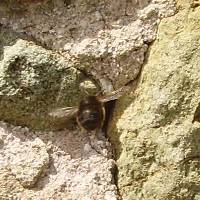

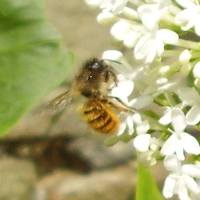
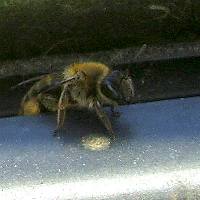
What are solitary bees?
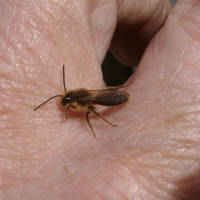
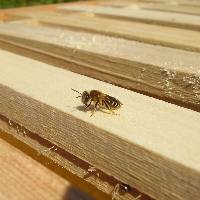
Most solitary bees are exacly that - they rear all their offspring on their own. Emerging as adults in spring, they mate and find or make a hole, collect pollen and nectar and lay an egg on a mass sufficient for the larva's needs. Then they close up the hole and continue until the hole is filled. Many, like the black mason bee (first image of anthropora plumipes), use mud to seal each compartment and the throat of the hole, which is in a soft area, such as a mud bank, crumbling mortar, or, in Cornwall and the South West, a cob wall (soil with straw, solid and protected with a skim or between granite stones). These are commonly called mason bees, in contrast to the mining bees or carpenter bees, whose names describe their nesting sites. The second picture shows a red mason bee leaving a hole in the same wall as the black. The tawny mining bee (andrena) is visiting a flower below the nests of both red and black mason bees in a wall in Helston. The tiny solitary bee (one of the many colletes) came into the car during a visit to an apiary. These seem to be the most elusive as they fly remarkably quickly evading the clumsy focusing of the digital camera! Frames prepared for honeybees also attract solitaries (left). Nests can be found in cornish hedges or walls and emerging bees take time to develop the strength to fly and mate. They can be easily picked up or, alas, killed by children mistaking them for dangerous beasties (right). In a local school, we all had the privilege of a mass spring emergence. The bees that survived the children's terrified mass murder, flew to just above a nearby bush to mate with the drones congregating there. The males are much smaller (preserving the mother's precious energy) as she alternates male and female in her nesting tubular holes until she can no longer lay).
Andrena in Stratford-upon-Avon
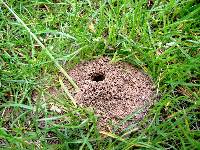
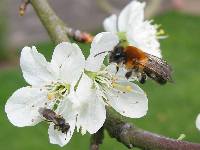
These pictures were taken by Peter Edwards who has kindly allowed me to publish them here. The originals, which are of higher quality, can be seen in the Newsletter of his local Association. These are common mining bees which you will often find in lawns or bare earth.
“2006 seems to have been good for the solitary mining bees (Andrena fulva) and we seem to have hundreds in our garden. For those that do not know this bee, they are responsible for the little ‘volcanoes’ that appear in lawns and borders at this time of year as the females dig their nests; males are small and drab, but the females have glowing chestnut coloured overhairs.
Their stings are unable to penetrate human flesh and they do excellent pollination work on early fruit such as plum and gooseberry. Unfortunately, some members of the public still think that they are dangerous pests - so if beekeepers get a call to ‘deal with’ swarms of bees living in holes in the ground, this is a great opportunity to do a little education.”
Attracting solitary bees to the garden
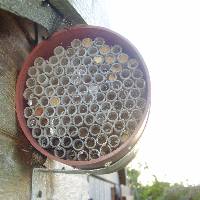
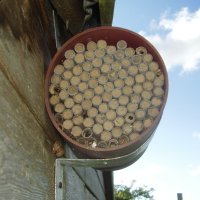
Oxford Bee Company developed nesting tubes designed for the red mason bee as illustrated and a smaller tube for the blue mason bee. The picture shows that they can also attract other bees, in this case a leafcutter bee (left - for detail see enlargement). They can be set up on a gate post or wall or any convenient support, best south facing. Then you wait! To purchase the tubes. Tubes and boxes including bumble bees. Mason bee specialists
Other designs of attractor include bundles of bamboo shoots or straws, holes drilled in wood, straws laid between slates or similar.
Two years later the tubes are almost all full with mason bees (right). They were very active until June 2008 and the last mother can be seen sealing a tube with mud - for detail see enlargement).
For further information on solitary bees visit a dated gallery and a BBC news article.